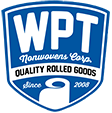Although many people are not familiar with the term ‘nonwoven fabric’ most everyone regularly uses some type of nonwoven fabric product in their daily life. Dryer sheets, feminine pads, diapers, cleaning wipes, landscape fabrics, and air filters are all examples of products made with nonwovens.

Unique Characteristics of Nonwovens
Nonwovens are generally considered fabric materials that are made through a bonding process rather than by knitting or weaving. Some who are familiar with nonwoven fabric may not realize there are many types of nonwoven fabrics, including different materials and processes used to make them.
When you consider that nonwoven products have unique characteristics, such as softness, stiffness, stretch, water resistance, absorbance and more, it is probably not surprising to learn that there are many different types of nonwoven fabrics.
Different Ways to Produce Nonwovens
Distinct nonwovens are produced using different fiber selections, web formations, bonding, coating, and finishing techniques to create the desired fabric characteristics and functional requirements. Here are just a few examples of different nonwovens that were highlighted in a Nonwovens Industry feature on the types of nonwovens:
Airlaid Nonwovens
Airlaid has the unique ability to lay down short fibers, either 100% pulp fibers, or mixtures of pulp and short cut synthetic fibers, to form a consistent and continuous web. Superabsorbent powders or fibers can be mixed in to create highly absorbent material.
Air Through Bonding (Thermal Bonding)
Through air bonding is a type of thermal bonding. Heated air flows through holes in a plenum above the nonwoven material, applying heated air to the surface of the nonwoven fabric. While hot ovens push air through the material, the through air process uses negative pressure to pull the air through the nonwoven material as it is drawn through the oven. Pulling air through the material allows the rapid and even transmission of heat to minimize distortion of the nonwoven material.
Meltblown
Meltblown nonwovens are produced by extruding melted polymer fibers through a spin net or die consisting of up to 40 holes per inch to form long thin fibers which are stretched and cooled by passing hot air over the fibers as they fall from the die. The resultant web is collected into rolls and subsequently converted to finished products.
Spunlaid (Spunbond)
Spunlaid, also called spunbond, nonwovens are made in one continuous process. Fibers are spun and then directly dispersed into a web by deflectors or can be directed with air streams. This technique is characterized by faster belt speeds and cheaper costs.
What Type of Nonwoven is Best for My Project?
Just as not all nonwoven materials are the same, not every type of nonwoven will provide the most beneficial characteristics for your project. WPT Nonwovens has extensive experience in assisting customers with selecting the right nonwovens, including the most advantageous fabric fiber types, coatings, finishes, and more.
In addition to being a knowledge, dependable US source for quality nonwoven fabric, WPT Nonwovens offers buyers many advantages as their nonwoven fabric supplier including:
- Advanced facilities that provide full capabilities to handle quick-change challenges
- Inline slitting and winding capabilities
- Nonwoven fabric samples delivered within 30 days
- Ability to schedule and run new and innovative trials quickly and efficiently
- Ability to affordably serve the needs of small quantity niche buyers as well as large quantity customers
- Dependable on-time delivery in four to six weeks
We are happy to serve order size and are committed to providing excellent nonwoven fabrics, along with full customer support and services!

